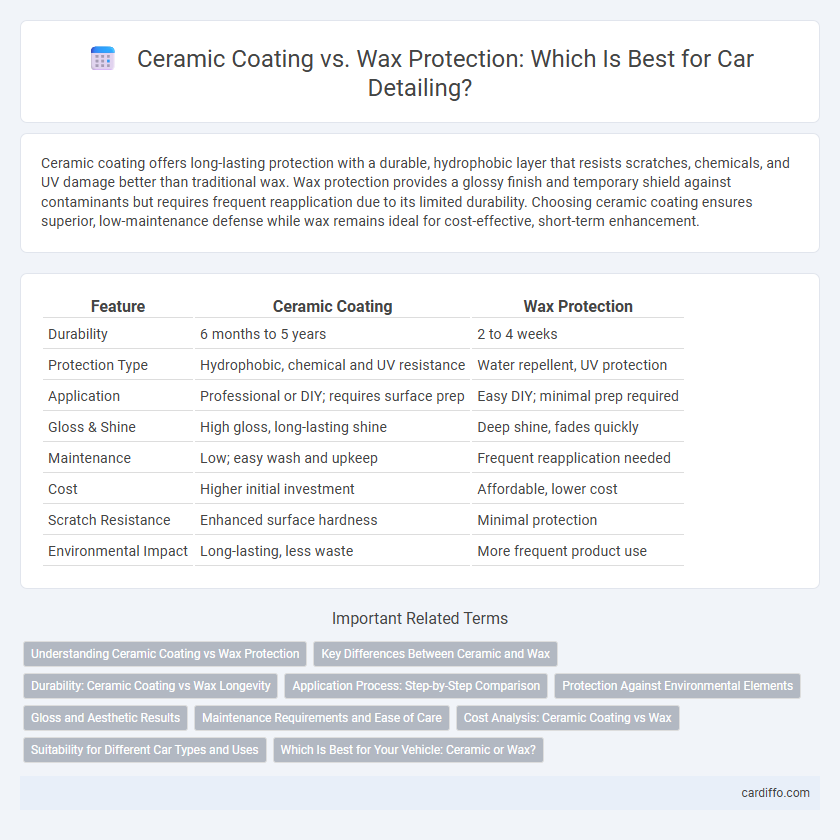Ceramic coating offers long-lasting protection with a durable, hydrophobic layer that resists scratches, chemicals, and UV damage better than traditional wax. Wax protection provides a glossy finish and temporary shield against contaminants but requires frequent reapplication due to its limited durability. Choosing ceramic coating ensures superior, low-maintenance defense while wax remains ideal for cost-effective, short-term enhancement.
Table of Comparison
| Feature | Ceramic Coating | Wax Protection |
|---|---|---|
| Durability | 6 months to 5 years | 2 to 4 weeks |
| Protection Type | Hydrophobic, chemical and UV resistance | Water repellent, UV protection |
| Application | Professional or DIY; requires surface prep | Easy DIY; minimal prep required |
| Gloss & Shine | High gloss, long-lasting shine | Deep shine, fades quickly |
| Maintenance | Low; easy wash and upkeep | Frequent reapplication needed |
| Cost | Higher initial investment | Affordable, lower cost |
| Scratch Resistance | Enhanced surface hardness | Minimal protection |
| Environmental Impact | Long-lasting, less waste | More frequent product use |
Understanding Ceramic Coating vs Wax Protection
Ceramic coating provides long-lasting paint protection through a durable, liquid polymer that chemically bonds to the vehicle's surface, offering superior resistance to scratches, UV rays, and chemical stains compared to traditional wax. Wax protection, made from natural or synthetic compounds, creates a temporary barrier that enhances shine but typically lasts only a few weeks and requires frequent reapplication. Understanding the differences in durability, protection level, and maintenance helps vehicle owners choose the best option for preserving their paint's finish.
Key Differences Between Ceramic and Wax
Ceramic coating provides long-lasting, durable protection by forming a chemical bond with the vehicle's paint, offering resistance to scratches, UV rays, and chemical contaminants for up to five years. Wax protection, typically made from natural or synthetic oils, creates a protective layer that enhances shine but lasts only a few weeks and requires frequent reapplication. Unlike wax, ceramic coatings offer hydrophobic properties that repel water and dirt more effectively, reducing maintenance time and preserving paint clarity.
Durability: Ceramic Coating vs Wax Longevity
Ceramic coating offers superior durability compared to wax, providing protection that can last between 2 to 5 years, depending on the product and maintenance. Wax protection typically lasts only a few weeks to a couple of months before requiring reapplication due to its organic composition. The enhanced longevity of ceramic coatings results from their chemical bonding with the vehicle's paint surface, creating a robust, hydrophobic layer resistant to environmental contaminants and UV damage.
Application Process: Step-by-Step Comparison
Ceramic coating application involves a precise multi-step process including surface preparation with thorough washing and claying, meticulous paint correction to remove imperfections, followed by careful application of the coating with a microfiber applicator and ample curing time. Wax protection requires a simpler procedure, starting with cleaning the vehicle's surface, applying wax in thin, even layers, and buffing after drying, typically needing frequent reapplications every few months. The ceramic coating process demands more time and expertise but offers long-lasting durability and stronger protection compared to the easier, less durable wax application.
Protection Against Environmental Elements
Ceramic coating offers superior protection against environmental elements compared to traditional wax due to its durable, hydrophobic properties that repel water, dirt, and UV rays for extended periods. Unlike wax, which typically lasts a few weeks, ceramic coatings bond chemically with the vehicle's paint, providing a robust shield against acid rain, bird droppings, and oxidation. This enhanced protection reduces the risk of paint damage and maintains the vehicle's glossy finish under harsh weather conditions.
Gloss and Aesthetic Results
Ceramic coating provides a durable, high-gloss finish that enhances the depth and clarity of paint, offering long-lasting protection against environmental contaminants. Wax protection delivers a warm, rich shine but tends to fade quickly and requires frequent reapplication to maintain its aesthetic appeal. The ceramic coating's superior gloss retention and hydrophobic properties make it the preferred choice for enthusiasts seeking a consistently vibrant, showroom-quality appearance.
Maintenance Requirements and Ease of Care
Ceramic coating offers superior durability with maintenance often limited to regular washing using pH-neutral shampoos, significantly reducing the need for frequent reapplications compared to traditional wax. Wax protection typically requires more frequent use, often every few weeks, as it wears off faster and is susceptible to environmental contaminants. The ease of care for ceramic coatings extends vehicle longevity with enhanced hydrophobic properties, minimizing dirt adhesion and streamlining the cleaning process.
Cost Analysis: Ceramic Coating vs Wax
Ceramic coating typically costs between $500 and $2,000, offering long-lasting protection that can endure for up to five years, reducing the need for frequent reapplications. In contrast, wax protection ranges from $20 to $100 per application but requires reapplication every few months, resulting in higher long-term maintenance costs. Evaluating cost-effectiveness, ceramic coating presents a higher upfront investment but provides superior durability and savings over time compared to regular wax treatments.
Suitability for Different Car Types and Uses
Ceramic coating offers superior durability and chemical resistance, making it ideal for daily-driven vehicles exposed to harsh weather and frequent washing, while wax protection suits classic and show cars that receive occasional use and require a high-gloss finish. For off-road and performance vehicles, ceramic coatings provide long-lasting protection against abrasions and contaminants, reducing maintenance time. Luxury and commuter cars benefit from ceramic coatings' hydrophobic properties, whereas wax can enhance the visual appeal of weekend or vintage vehicles without the need for professional application.
Which Is Best for Your Vehicle: Ceramic or Wax?
Ceramic coating offers long-lasting protection by creating a durable, hydrophobic layer that resists scratches, UV rays, and chemical stains, making it ideal for vehicle owners seeking minimal maintenance and maximum protection. Wax protection provides a glossy finish and enhances paint depth but typically lasts only a few weeks to months and requires frequent application to maintain effectiveness. Choosing between ceramic coating and wax depends on your budget, desired durability, and willingness to commit to regular upkeep.
Ceramic Coating vs Wax Protection Infographic

 cardiffo.com
cardiffo.com